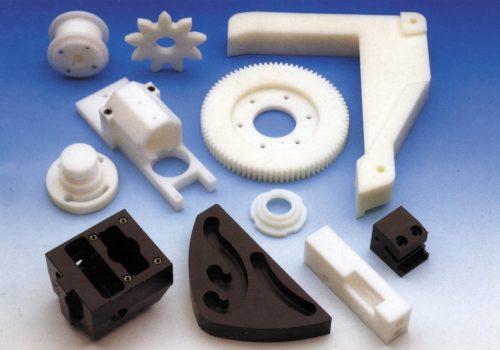Sourcing Solutions for Composite Materials
Leave a Comment
You have been tasked with finding new sources for non-metallic components – where to go?
There is always a web search, but that will only get you a list prioritized by how well each company can work the search algorithm.
- Are they qualified to produce my parts?
- Can they answer my questions?
- Will they offer me alternative materials and help me make the right choices for MY company, not theirs?
Look no further – we can help!
Having offered custom non-metallic solutions in a wide range of industries for well over 100 years, WS Hampshire knows how to evaluate your application to determine the most appropriate composite material as well as what design considerations must be evaluated.
There are often times multiple ways to make a given part, largely depending on volume, desired performance, and cost. Expertise in this area can save you money and a lot of headaches! Raw material selection is key to performance in the application and some parts can be made from sheet or tube while others can be made from a casting or extrusion. Knowing how, when, and why to use a specific material can make a world of difference in what your part costs and how well it performs.
With these and other sourcing considerations – the experts at WS Hampshire can walk you through how to obtain your composite parts in the most cost-effective manner.
For example : A beverage OEM was buying a “U-Channel”, made in virgin UHMW. His previous source machined the part from plate, which was costly in two ways (additional material and additional machining). The finished channel had a rough machined pattern on the inside surfaces which caused drag as bottles slid within the channel. An extruded version offered by WS Hampshire, requiring only slight secondary machining for the attachment holes. Even after amortizing the relatively inexpensive tool, the OEM saved over 30% per foot with a smooth finish and lengths longer than 10 ft were now available – a high ROI with a superior product!
Positive Environmental Impacts of Plastic
Leave a CommentMaterials touted as “all natural alternatives” to plastic were often actually replaced by plastic decades ago because it was better for the environment.
Plastics have been saving the planet since long before there was Earth Day, an annual event supporting environmental conservation. Despite the massive amount of single use plastic waste that irresponsibly enters our oceans, plastics actually play an important role in protecting the environment.
In 1869, John Wesley Hyatt used natural cellulose to create a substitute for the ivory used in piano keys, billiard balls, and similar products. The result was a substantial decrease in the slaughter of elephants for their tusks. Hyatt’s invention also replaced tortoise shells used for jewelry, hair combs, picture frames, and many more household items. New plastics were then created and quickly began replacing other environmentally harmful materials. In the 20th century, plastics began to replace paper, natural rubber, and even silk, all of which prevents deforestation.
The reality is that plastic has saved many species from possible extinction expanding access to products for working and middle-class people.
Plastics also replace energy-intensive iron and steel in auto manufacturing, construction and process industries. Examples include better wearing composite stripper blades in steel mills and nylon sheaves used in construction cranes.
Plastics Offer Safety Advantages
From sheaves for lifting equipment to slipper blocks in steel mills to slide bars on pile driving equipment to car windows and aircraft hangar door rollers, plastics offer a greater degree of safety. Typically, about 1/7th the weight of steel, iron or bronze, installation is much easier with one person able to install components that used to take two people or even a crane. Yes, finding discarded plastic bottles along the road is irritating – but those of us with some years behind us remember all the broken glass from beer and soda bottles along the road that used to take out our tires. Glass processes at ~2800F in an extremely long process – that’s over 5 times the temperature, and vastly more energy, required than to make plastic bottles
Plastics Actually SAVE Energy and Water Resources
Plastics save water and energy, too. Corroding metal pipes result in the loss of ~17% of all water pumped in the United States and more than $50 billion a year in maintenance and replacement costs. Plastic piping can last more than a century and corrosion resistant plastics extended the life of pumper truck tank applications in agriculture and fire-fighting equipment. Plastic insulation saves 40 times the energy required to make it while offering excellent shipping/fuel cost savings.
Plastics Benefit Conservation
Plastics are important to virtually every human activity today, including environmental conservation. Waste management and recycling is a major focus of the plastics industry as a means to continue society’s progress.
The same spirit of innovation that created environmentally responsible replacements for ivory and tortoise shell is developing new materials, designs, and recycling methods that conserve resources and reclaim the value of used or discarded plastic.
Recycling innovations include optical sorting, light-reflection technology to identify a variety of difficult-to-sort recyclable materials. Advanced recycling is an environmentally safe process that returns plastic to its basic chemical building blocks for reuse.
And it might sound like science fiction, but enzymatic recycling — bacterial compounds that “eat” plastic waste and produce new plastic — are in the works and could become a reality.
Let’s Focus on What Works-
Today, innovation in life-cycle technology is the best key for the world to continue to reap the benefits of composite materials while minimizing solid waste. Companies are now transforming windshield safety glass into new carpets and removing contaminants from recycled material to produce near-virgin-quality resins. In one case, a parking lot was paved with the equivalent of 71,000 recycled plastic bags.
Did you know plastic bags require 70% less energy and 96% less water to manufacture than paper bags? And you can’t pave a parking lot with paper bags.
Constant innovation is why we should never ban plastic materials or products that conserve resources and protect the environment — important to remember on Earth Day and every day!
There are bills in Congress offering practical, bipartisan solutions. The RECOVER Act would improve collection and sorting of recyclable materials. The RECYCLE Act would fund public awareness of recycling options. The Plastic Waste Reduction and Recycling Act would develop new recycling technologies.
When activists seek to ban or severely restrict the usage of plastic, it’s important to consider what materials would serve as replacements. More often than not, plastic actually replaced these other materials decades ago due, in part, to being more environmentally friendly. Let’s embrace innovation and build upon what works!
Tom Connelly is a self proclaimed “Street Engineer” with over 40 years in the plastics industry.
Nylon or Acetal- How to choose
Leave a Comment
Two of the most widely used engineering thermoplastics are nylon (polyamide, “PA”) and acetal (polyoxymethylene, “POM”). The choice between the two can be difficult since their basic physical properties are similar. (FUN FACT –“Nylon” was once DuPont’s trade name for PA, but they didn’t protect it and it became the generic description!)
For our purpose here, we are discussing these materials in general terms without differentiation of extruded vs cast in nylon and homopolymer vs copolymer in acetal.
Material Cost
Acetal shapes tend to be more expensive than nylon by about 10%. The difference gets larger as size increases due to the economy of casting nylon in large shapes.
Availability
New technology allows acetal to be available in plate up to 10” thick and rod to 24” diameter as well as tubes up to 20” OD. Nylon is available in both small and massive shapes (78” diameter sheaves and 14 ft long slide bars have been cast in nylon). Additionally, nylon is readily available in custom profile extrusions (edge guards, clip-on wear strips) where acetal generally is not.
Formulations
Nylon has a wide availability of modified versions to improve wear resistance, heat stability, impact resistance and flame retardancy. Acetal has some of these variations but less than the nylon family.
Key Differences
Machineability
Both materials machine well, but nylon is known to generate chip wrap requiring spindle clearing. Both materials can be finished to excellent surface finishes
Moisture Absorption
Nylon picks up ~2.5% moisture atmospherically, and up to 7% at saturation. This factor can inhibit dimensional stability and wet wear resistance. Acetal’s water absorption is 0.2% and 0.9%, respectively, which allows for closer tolerances in wet environments.
Wear Resistance
As a general rule is that nylon will outwear acetal by ~4:1 in dry applications and acetal will outwear nylon by the same ~4:1 ratio in a wet environment.
Summary
In most applications, many materials will work and the selection of the most appropriate candidate material can rest other considerations. WS HAMPSHIRE has the expertise to ask the right questions and make effective recommendations to assist you in finding the right material at the right price for your application!
Tom Connelly is a self proclaimed “Street Engineer” with over 40 years in the plastics industry.
You’re in the Right Place
Leave a Comment
Here at WS Hampshire, customization and problem solving are a way of life. We do a little of everything with applications including wear parts in steel mills, insulation for the lighting industry, sheaves and wear pads in construction equipment and fire trucks, thermal insulation, structural fiberglass, and custom composite components for almost any aspect of industry. Our global supply chain means that we have access to a wide variety of composite materials and can determine the best raw material and grade for your specific application.
Our team fully understands that no two applications or customers are the same and is happy to help with a custom order for a unique project, or to build a large scale stocking program to keep your operation running.
Whatever your needs, know that you are in the right place!
Contact us and let us know what you are working on today.

